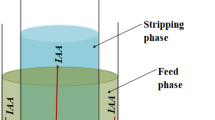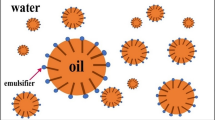Abstract
In this study, the removal of nitrate (NO3 −) ions from aqueous streams with liquid membrane technique has been investigated. Among the other parameters (temperature, pH, acceptor phase type and medium concentration), the stirring speed was chosen as process parameter. From the experimental results, it has been determined that the reaction was diffusion controlled. The transport efficiency of nitrate ions increased with increasing stirring speed. The membrane entrance and exit rate constants (k 1d, k 2m and k 2a respectively) were linearly dependent on the stirring speed ratios of 100 to 250 rpm.
Coupled transport of nitrate ions through a liquid membrane in 85% n-hexane-15% tricloromethane as diluent, containing tetraoctyl ammonium chloride (TOACl) as a carrier was examined at various stirring speeds. Membrane entrance (k 1d) and exit rates (k 2m and k 2a) increase with increasing the stirring speeds. The diffusion of the nitrate ion-carrier complex through the narrow stagnant layers was found to be rate determining step. The membrane was stable during the transport experiments. There is no leakage of carrier or nitrate ion-carrier complex to both aqueous phases and also, no supplementary water penetration into the membrane. This favours interfacial reaction of nitrate ion and carrier.
Similar content being viewed by others

Author information
Authors and Affiliations
Additional information
Received: 11 March 1996
Rights and permissions
About this article
Cite this article
Demircioğlu, N., Topçu, N., Levent, M. et al. Effects of stirring speed on coupled transport of nitrate ions through liquid membranes. Bioprocess Engineering 22, 309–314 (2000). https://doi.org/10.1007/s004490050737
Issue Date:
DOI: https://doi.org/10.1007/s004490050737



